WPI Project Program
At Worcester Polytechnic Institute (WPI),engineering, science, and business students alike have the opportunity to complete two projects addressing current local and/or global issues. Many of these projects incorporate sustainability and seek to make a long-lasting positive change. We can measure progress towards climate resilience in terms of sustainability by the Sustainable Development Goals (SDGs). Each project tends to meet at least one of these 17 goals developed by the United Nations in 2015. To learn more about current sustainability efforts at WPI, please visit our Sustainable Living & Learning Laboratory website.
Students in their Junior year complete an Interactive Qualifying Project (IQP). Each year, over 1,000 WPI students take their projects off WPI’s campus as part of the . Many choose to go abroad; immersing themselves in different cultures as they work on projects improving the local community. On this page, you can learn more about WPI’s many student-driven projects done in Aotearoa New Zealand.
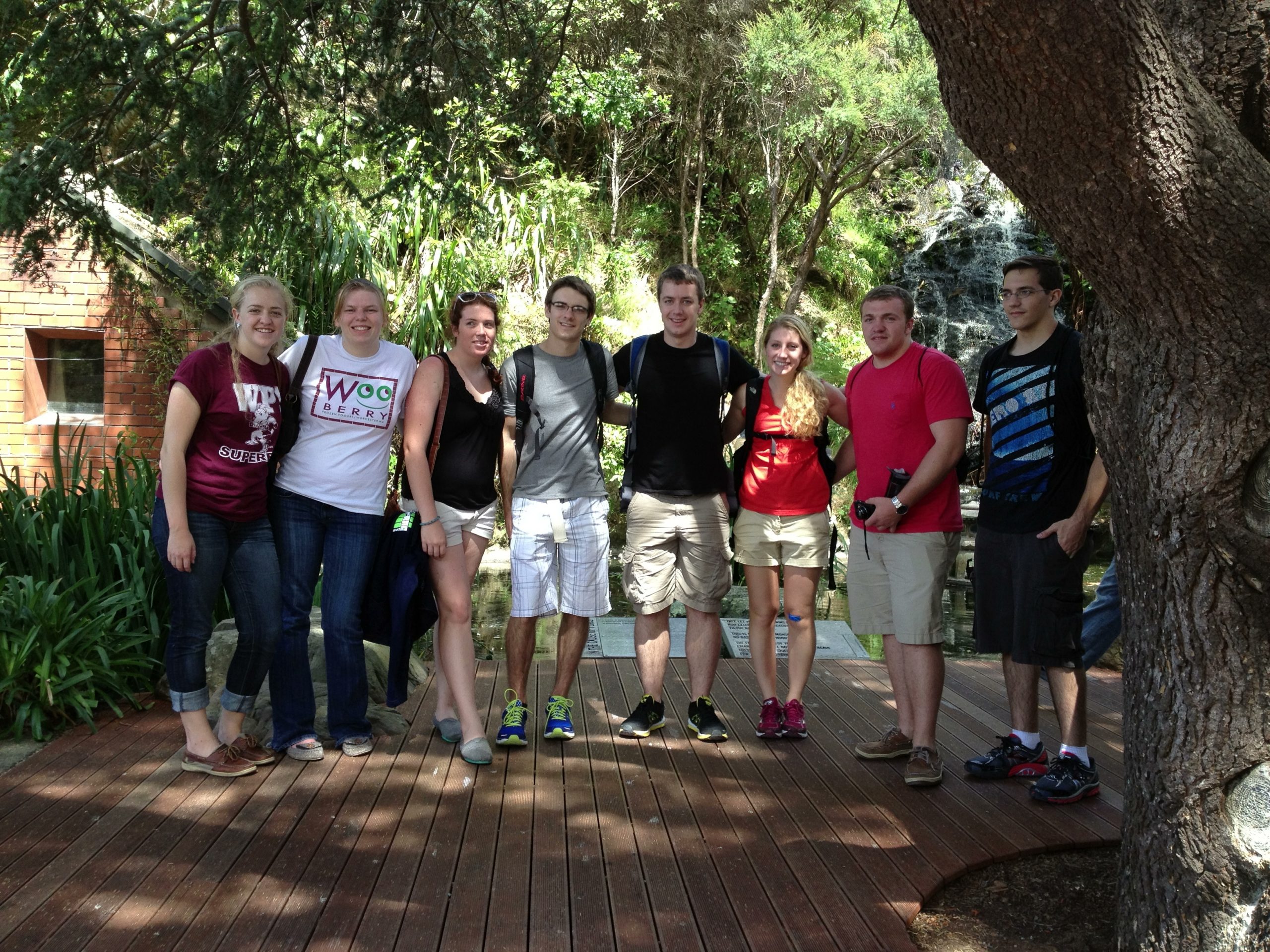




Cultural context is necessary for students to build connections and conduct responsible research on their Interactive Qualifying Project (IQP), especially with regards to Indigenous communities, and this is not adequately provided in the current preparation phase of the IQP. To supplement existing resources, we created the Just IQP Research website for ethical partnership with Māori communities, using insights from our research including interviews with past IQP students, advisors, and scholars in New Zealand who have collaborated with the Indigenous Māori population. The website, wp.wpi.edu/justiqpresearch, focuses on 6 key concepts that emerged from our research: culture and history, language, reflection, discomfort, ethical listening, and accountability.
SDGs
4 – Quality Education, 10 – Reducing Inequality, 16 – Peace, Justice, and Strong Institutions
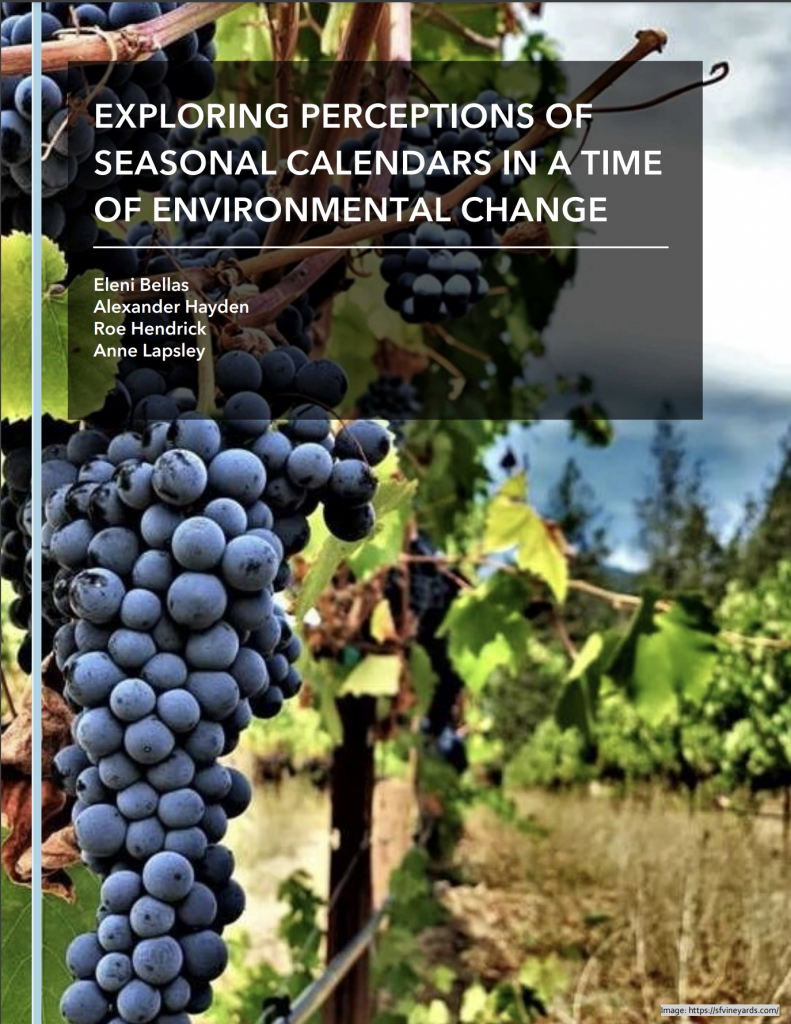
SDGs
13 – Climate Change

The purpose of our project was to create a set of recommendations to improve water quality in Wellington, New Zealand. We accomplished this by interviewing water quality experts in Wellington as well as Massachusetts, U.S, and reviewing successful water quality management practices implemented in Massachusetts and beyond. Our research identified areas of critical need and potential intervention in Wellington. Our recommendations include possible communication strategies needed to make the proposed technical solutions more effective within the context of Wellington.
SDGs
3 – Good Health and Well-being, 6 – Clean Water and Sanitation, 9 Industry, Innovation and Infrastructure, 11 – Sustainable Cities and Communities, 12 – Responsible Consumption and Production, 13 – Climate Action, 14 – Life Below Water, 15 – Life on Land

As climate change is an increasingly serious global problem, the goal of our project was to document response strategies in New Zealand. We conducted 14 interviews with decision makers in critical economic sectors to gather these strategies and assess their impacts. Our findings were categorized into governmental policies and actions, and technical solutions implemented by companies within different sectors. Based on these interview results, we recommended a series of solutions to the United States based on current greenhouse gas emissions by economic sectors.
SDGs
9 Industry, Innovation and Infrastructure, 11 – Sustainable Cities and Communities, 12 – Responsible Consumption and Production, 13 – Climate Action

The health of the Wairarapa Moana has rapidly degraded and has achieved Ramsar international conservation status. This IQP team was tasked with gathering information and perspectives from local Māori and other community members in order to assess and monitor the health of the lake. They found overarching community goals for the lake and created a framework which physically demonstrates the interrelation between Mauri, Ramsar criterion, community goals and elements of the Wairarapa Moana. The array of wetland environments within the Wairarapa Moana allows the ecosystem to support a variety of diverse species. This area is home to over 50 rare and threatened species, as well as an abundance of other native species. By working with regional communities to monitor and protect the wetland, the team found they could protect the environment as well as important spiritual, social, and practical elements of people’s lives that depend on the Moana for many reasons.
SDGs
13 – Climate Action, 14 – Life Below Water, 17 – Partnerships for the Goals

The New Zealand Sea Lion (pakake) population has declined significantly over the past two decades, having led the New Zealand Department of Conservation (DOC) to take action in conserving them. The purpose of this project was to prototype an online citizen science platform that enables DOC to monitor the effectiveness of sea lion protection shelters, and to educate the public. We successfully created a citizen science platform, Sea Lion Aotearoa, on Zooniverse that meet’s DOC’s requirements. With the interest and assistance of the public, DOC will be able to monitor pakake populations more accurately and how effective the shelters are at protecting them from harsh conditions.The purpose of this project was to prototype an online citizen science platform, using image analysis, that enables DOC to educate the public and raise funds for conservation efforts. In order to meet this goal, we identified three objectives: explore outreach and science communication techniques for educating the public so that we use informative, engaging, and clear messaging, understand best practices in citizen science platform designs to determine how they work and how we could structure our platform, and finally, assess feedback from platform development to improve user experience.
SDGs
4 – Quality Education, 13 – Climate Action, 14 – Life Below Water, 15 – Life On Land, 17 – Partnerships for the Goals

Off-lead dogs create a risk to the biodiversity of New Zealand on national shorelines through hazardous interactions with wildlife. This report details a collaboration with the Department of Conservation’s (DOC) Lead the Way (LTW) campaign, which promotes the sharing of the beaches. By researching online information about the consequences of dog and marine wildlife interactions and analyzing the Dunedin and Canterbury LTW pilot programs, along with surveying dog owners across New Zealand, we developed recommendations to scale up the LTW program for national implementation.
SDGs
14 – Life Below Water, 15 – Life On Land
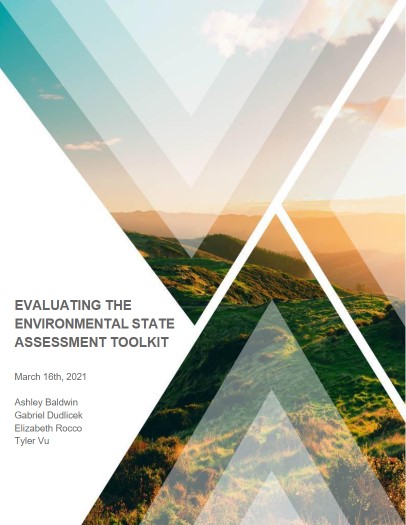
Ecosystem-Based Management Tools (EBMTs) are often used by professionals to evaluate the health of specific environments. Often, these tools utilize narrow western metrics of ecosystem health and fail to incorporate Indigenous knowledge. We evaluated ESAT, an EBMT that accounts for Indigenous cultural values. We determined the necessary steps for the tool to be successfully implemented in countries such as the U.S., and we provided insight as to how ESAT can be successfully developed from a technical and functional level.
SDGs
6 – Clean Water and Sanitation, 10 – Reducing Inequality, 11 – Sustainable Cities and Communities, 13 – Climate Action, 14 – Life Below Water, 15 – Life On Land, 17 – Partnerships for the Goals

A majority of the wetlands in the Ruamahanga catchment are degraded from efforts to control flooding and create farmland. We collected perceptions of wetlands to the Wairarapa community from key stakeholders. We found strong connections to the wetlands and a wish for the same opportunities for generations to come. We also found that wetland restoration suffers from a lack of collaboration and incentives between community groups. We propose opportunities for collaboration, increasing education, and expanding incentives for restoration.
SDGs
3 – Good Health and Well-being, 6 – Clean Water and Sanitation, 8 – Decent Work and Economic Growth, 12 – Responsible Consumption and Production, 15 – Life On Land, 17 – Partnerships for the Goals

In order to promote effective collaboration on climate actions and foster community engagement, Greater Wellington Region Council has decided to implement a unified climate action resource. We collaborated with GWRC to produce a streamlined resource prototype that compiles and highlights area climate change actions and meets additional needs and preferences from agencies and organizations in the Wellington Region. Using a baseline assessment, interviews, a survey, and feedback groups, we collected information that informed the design of a resource prototype.
SDGs
13 – Climate Action
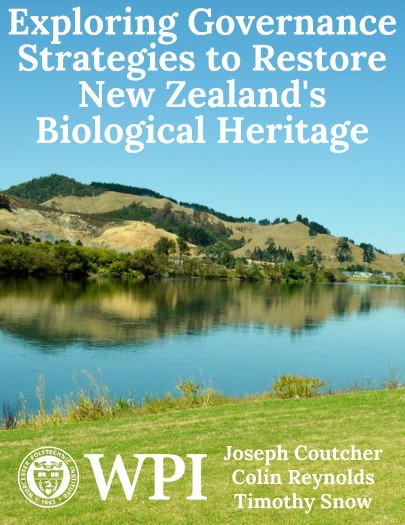
New Zealand’s biological heritage and security of native ecosystems are threatened by the introduction of invasive organisms, climate change, and anthropogenic activity. This project evaluated governance models to identify strategies that best restore Aotearoa’s biological heritage. This analysis included establishing an understanding of tikanga, documenting community perspectives, and comparing strategies and indicators of desirable bioheritage governance outcomes. The project found that locally-driven, strongly legislated, and two-eyed approaches to management are more effective at achieving shared goals in restoring biological heritage.
SDGs
14 – Life Below Water, 15 – Life On Land, 16 – Peace, Justice, and Strong Institutions

Sea level rise (SLR) due to climate change is a global threat. Interactive maps illustrate the effects of SLR for the public but their impact is unclear. We conducted interviews with map developers, climate change scientists, and science communication experts, and distributed a public survey, to understand how best to engage the public. We determined that interactive maps are not the most effective method of SLR communication, and we recommend that NZ SeaRise develop a centralized platform for all information regarding SLR.
SDGs
13 – Climate Action

Zealandia ecosanctuary, located in Wellington, New Zealand, is devoted to the conservation of the country’s native environment, focusing mainly on bird species. Since the ecosanctuary’s founding, the populations of these species have increased significantly and have begun to spread beyond the fence into the surrounding suburbs. This is known as the “spillover effect” and it has created a need to understand the awareness people have of native bird life. The goal of this project was to create a survey that measured the awareness people in Wellington have of the native bird life, to analyze the data gathered, and to give outreach recommendations to Zealandia based on the analysis performed.
SDGs
4 – Quality Education, 13 – Climate Action, 15 – Life on Land
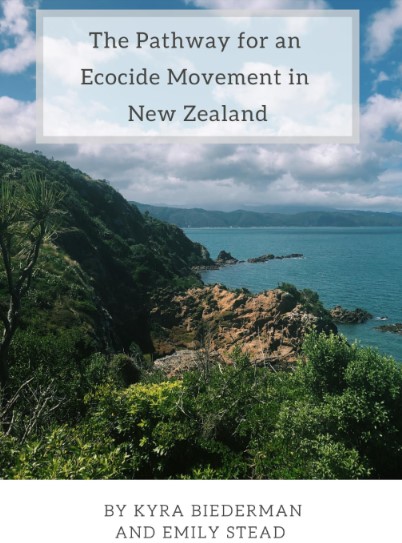
The goal of this project is to provide our sponsor, Island Reach, with initial research relating to the common themes between concerned citizens and the New Zealand government. This will help our sponsors create a strategy to urge New Zealand to become a supporter of an international crime of ecocide written under the Rome Statute. Ecocide as international law would allow states protected by the ICC to prosecute powerful individuals for mass ecological damage. Through these similarities, we can conclude that the media can be a powerful tool to influence and educate people about the term ecocide, the timing for the introduction of an ecocide law depends on the members in office, and a member of Parliament needs to act as an advocate for an international crime of ecocide.
SDGs
9 – Industry, Innovation, and Infastructure, 12 – Responsible Consumption and Production, 13 – Climate Action, 16 – Peace, Justice, and Strong Institutions

The Pest Free Upper Hutt (PFUH) organization, located in Upper Hutt, New Zealand, works with the local community to eradicate non-native pests to increase native birdlife in the area. We analyzed the barriers to participation and identified opportunities to increase awareness of, and participation in, the program. We accomplished this by interviewing the public and numerous coordinators and through an online survey that geographically targeted the Upper Hutt area. Based on these findings, we produced recommendations to further increase involvement in PFUH.
SDGs
10 – Reducing Inequalities, 11 – Sustainable Cities and Communities, 15 – Life on Land

An international ecocide law requires two-thirds of States Parties of the International Criminal Court to vote in favor of establishing it as an amendment to the Rome Statute. Our sponsors, Island Reach and Shirleen Chin, want to gauge the feasibility of New Zealand joining as a supporter. This project assessed the stance of key Māori leaders and philosophers, and the New Zealand government on environmental justice, and how these views may align with an ecocide movement. Through archival research, semi- structured interviews, and participant observation, we delved into the environmental and legal influence of Māori culture. Our analysis of the Māori philosophy and New Zealand legislation may help assess a pathway for an ecocide law.
SDGs
10 – Reducing Inequalities, 11 – Sustainable Cities and Communities, 16 – Peace, Justice, and Strong Institutions

Food insecurity is defined as the lack of access to an adequate quality and quantity of nutritious food. Food insecurity is a “nested issue” under the umbrella of poverty, and stems from inadequate incomes and high living costs. Approximately 14.0% of the New Zealand population is food insecure and needs assistance. In this project, we found a lack of coordinated government policies and discovered a network of non-governmental organizations committed to responding to the growing issue of food insecurity.
SDGs
1 – No Poverty, 2 – Zero Hunger, 10 – Reducing Inequalities, 16 – Peace, Justice, and Strong Institutions

Seaview Gracefield is an industrial hub, located in a low-lying coastal area at the confluence of the Waiwhetu stream and the Hutt River near Wellington, New Zealand. Hoping to mitigate the area’s flood risk exacerbated by sea-level rise, the Greater Wellington Regional Council plans to develop an adaptive pathways land-use plan. We created an informative climate scenario for businesses during interviews. We gathered various perspectives of business leaders to gauge the level of awareness and planning regarding future sea-level rise in the area. We encountered a large spectrum of perspectives. In order to generate community engagement, we developed a serious game called the Seaview Sea-level “Sea-narios” game to communicate climate risks to businesses.
SDGs
10 – Reducing Inequalities, 11 – Sustainable Cities and Communities, 13 – Climate Action, 15 – Life on Land
